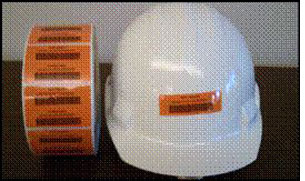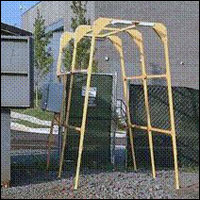General contractors and builders at more than 30 construction sites within the United States are employing an RFID-enabled solution provided by ADR Software to track the number of workers on those sites, as well as their identities. By utilizing the Workforce Monitor service, construction projects’ managers and supervisors can capture the identity of each worker entering or leaving a site, by means of Workforce Management Stations—RFID portals that read EPC Gen 2 passive ultrahigh-frequency (UHF) RFID tags attached to hardhats.
ADR’s Workforce Monitor software application processes the data from readers related to individuals passing through the portal, providing a user with such details as which contractors have employees on site, the number of workers at that location, whether those personnel have the necessary training or certification required to be there, workforce demographics and the workers’ zip codes—thereby enabling a user to know how many local jobs were created by that project. The solution also provides such information as which workers have gone belowground on sites in which trenches or tunnels, for example, are being dug. Thus, in the event that an emergency occurs, supervisors would know, in real time, who was below grade.
The system has been deployed at multiple sites, and has registered approximately 15,000 workers to date, from hundreds of contractor companies, says Bruce Labovitz, the cofounder and president of ADR Software, a startup company based in Reston, Va. At the construction site of the Washington Marriott Marquis Hotel, located in Washington, D.C., the system has been in operation for about two months, says Kenny Arnold, the general superintendent at the project’s general contractor, Hensel Phelps Construction Co.‘s mid-Atlantic district. The solution is designed to be easy to install and use, the company reports, thereby enabling it to be temporarily set up for the duration of a construction project, and to then be removed. Users pay a monthly service fee for the entire solution, which provides them with use of the hardware, as well as access to data on a personalized Workforce Monitor Dashboard, located on ADR Software’s hosted server.
With the system in place, each worker is provided with an adhesive-backed Alien Technology Squiggle RFID tag fastened to the front of a hardhat (on its exterior or interior surface). The tag’s unique ID number is then linked to that individual’s name and address, along with other details, such as the worker’s employer and training history.
ADR installs reader portals at the job site’s entrances and exits (which are often the same location). At each portal, one four-port Alien ALR-9900+ reader and four Laird Technologies polarized RFID antennas are deployed, one on each side of the portal, in order to capture the sequence by which a tag is read, thus indicating to the software whether that tag is entering or exiting the site.
Labovitz likens the technology to E-ZPass, the RFID-enabled toll system used by commuters in the Northeast. Without a solution like ADR’s, he says, construction-site managers usually must post an individual with a clipboard to record who enters or exits, or utilize magnetic-stripe badges that must be manually scanned—or, in many cases, they must simply rely on subcontractors to tell them who was there at a particular time. However, says Arnold, who is overseeing work at the Washington Marriott site, knowing exactly who is on-site not only provides safety benefits, but also helps the site’s general contractor or owner to verify invoicing from subcontractors, and also foresee possible delays. For example, he says, if the project calls for 12 workers each day from a specific subcontractor, and if he sees that only eight are arriving daily, “I know that we may be looking at delays.” At that point, he indicates, he can then respond by contacting the subcontractor, for example.

Arnold says his priority was to gain real-time data regarding which personnel are below grade as workers descend as much as 100 feet beneath the surface to perform their work. “I need to know who is down and who has come back up,” he states. And because an individual worker’s details are linked to the ID number on that person’s hardhat’s RFID tag, Arnold not only knows who is belowground, but also his or her phone number and emergency contacts. However, he says, after the system was installed in October 2011, he discovered that it would provide other benefits as well. For example, by tracking who enters and leaves the site, he can also gain details as to the quantity of D.C. residents on the job site. The worksite contract, he says, requires that a percentage of the project’s workers comprise local laborers.
The site includes workers from a variety of subcontractors, with a total of about 125 tags in use. ADR installed a portal at each of the two pedestrian access points into the construction site, and workers can walk through either on their way into and out of the site. Each Alien ALR-9900 reader is connected to a PC that runs the Workforce Monitor application, communicating with the back-end hosted server via a cellular connection. As an individual arrives, his or her ID number is stored in the Workforce Monitor software, along with that person’s status as being on-site. If the worker leaves through either portal, the software determines that he or she is moving off-site rather than into it, and updates that individual’s status accordingly.
Because underground work has yet to begin at the construction site, Arnold says he is not yet using the data to track who goes belowground. However, he says, once this commences over the next few months, he will use one of the existing portals, moving it to the digging area entrance, or add an additional portal to the two existing ones.
One challenge for Arnold has been how to ensure that staff members use the portals, rather than entering or exiting the site through the vehicle egress. Because workers were not using the portals, he has simply posted an employee at the vehicle-access area for now, to redirect employees arriving on foot to utilize the portals.
ADR Software, Labovitz says, was founded in 2009 to develop a solution that uses “RF technology that would allow the movement of workers without them having to stop.” The first prototype was completed during the second quarter of 2010, and the rest of that year was spent testing the system. The greatest challenge, he says, involved ensuring that every hardhat’s tag would be read, regardless of a worker’s height or walking speed.
Following the testing period, the system was commercially launched in January 2011, and it has since been used at between 30 and 40 construction sites by general contractors and building owners throughout the mid-Atlantic and Denver areas, as well as increasingly in other parts of the United States.


